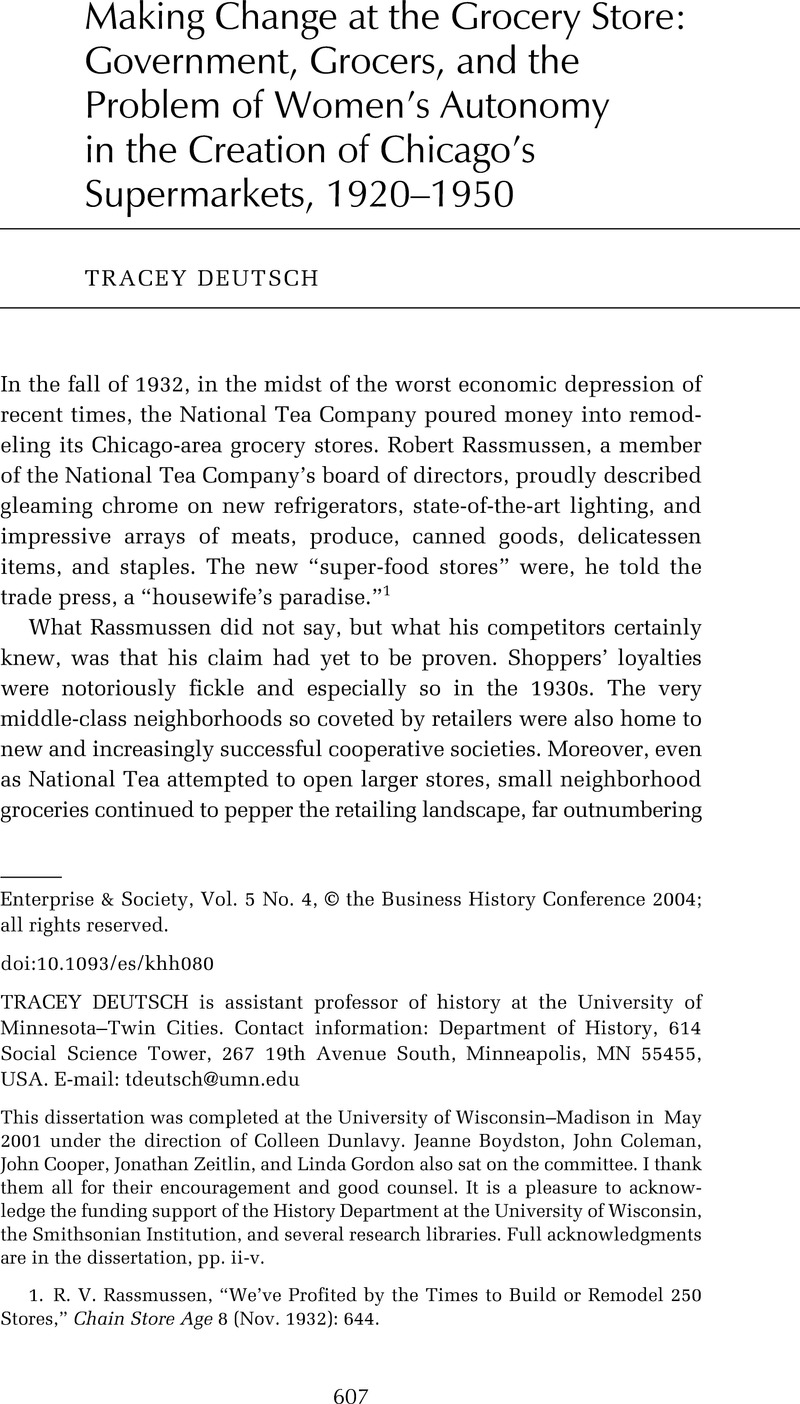Article contents
Making Change at the Grocery Store: Government, Grocers, and the Problem of Women’s Autonomy in the Creation of Chicago’s Supermarkets, 1920–1950
Published online by Cambridge University Press: 18 February 2015
Abstract

- Type
- Dissertation Summaries
- Information
- Copyright
- Copyright © The Author(s) 2004. Published by Cambridge University Press on behalf of the Business History Conference. All rights reserved.
References
1. Rassmussen, R. V., “We’ve Profited by the Times to Build or Remodel 250 Stores,” Chain Store Age 8 (Nov. 1932): 644.Google Scholar
2. For brief but important treatment of mass distribution, see Chandler, Alfred D. Jr., The Visible Hand: The Managerial Revolution in America Business (Cambridge, Mass., 1977), 233-35.Google Scholar Richard Tedlow has provided the most serious treatment among business historians in his survey of mass distribution. See Tedlow, Richard, New and Improved: The Story of Mass Marketing in America (New York, 1990).Google Scholar Two older but useful treatments are Lebhar, Godfrey M., Chain Stores in America, 1859–1962 (New York, 1963)Google Scholar and Zimmerman, Max, The Super Market: A Revolution in Distribution (New York, 1955).Google Scholar This dissertation was also informed by new work that has highlighted the politics of consumption, particularly that of Cohen, Lizabeth, especially Making a New Deal: Industrial Workers in Chicago, 1919–1929 (New York, 1990)Google Scholar; and Jacobs, Meg, “The Politics of Purchasing Power: Political Economy, Consumption Politics, and State-building, 1909-1959” (Ph.D. diss., University of Virginia, 1998).Google Scholar Much of this work reinforces the significance of consumption but raises questions about the contexts in which consumption happened—in particular, the relationship between retailers’ decisions and government policy. It is this connection that my dissertation sees as crucial to the history of American retailing and to the consumer society that stores undergirded.
3. For a statement to this effect and an overview of grocery stores’ importance, see U.S. Department of Commerce, Census of Business, 1954, vol.1: Retail Trade, Summary Statistics (Washington D.C., 1957), 7-8. Census officials noted that grocery stores “have been the most important single kind of business in every Census of Business.” They did $735,279,211 in sales in 1929 (14.9 % of total retail sales); $7,721,753,000 in 1939 (18.36% of total retail sales); and $130,520,548,000 in 1948 (18.97% of total retail sales). Sources: U.S. Department of Commerce, Fifteenth Census of the United States: 1930, Distribution, vol.1: Retail Distribution, Part II (Washington, D.C., 1934), 2 Google Scholar; U.S. Department of Commerce, Sixteenth Census of the United States: 1940: Census of Business vol. 1: Retail Trade: 1939, Part 1 (Washington D.C., 1943), 63 Google Scholar; U.S. Department of Commerce, United States Census of Business, 1948 vol. 1: Retail Trade—General Statistics, Part 1 (Washington, D.C., 1952), 104.Google Scholar It should be noted that the figures on this last table are slightly different from those given in the tables in earlier censuses. Revisions that I have identified do not differ widely from the originally published data, however, and it is difficult to ascertain the reasons for the revisions. Hence, I have always used the figures as they were originally published.
5. On chain store firms’ use of self-service, see chapter 1 of my dissertation, as well as Mayo, James, The American Grocery Store: The Business Evolution of an Architectural Space (New York, 1993), 89–92 Google Scholar, 134, 177-78, 241; and Ernest Shideler, Hugh, “Chain Stores in Chicago” (MA thesis, University of Chicago, 1927).Google Scholar On the disagreement over what constituted a supermarket, and whether the first ones ought to be labeled as “independent,” see Lebhar, , Chain Stores in America, 31.Google Scholar
6. U.S. Department of Commerce, Sixteenth Census of the United States: 1940, Census of Business, vol.1: Retail Trade: 1939, Part 1, United States Summary (Washington D.C., 1943), 817.Google Scholar
- 2
- Cited by


